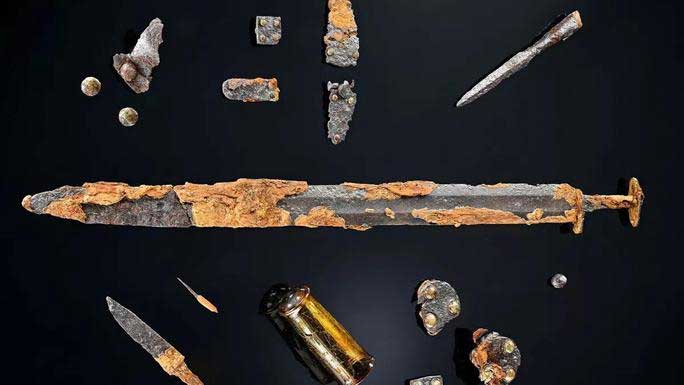An ancient tomb dating back 5,000 years and 140 additional tombs from 1,400 to 1,500 years ago, containing numerous incredible treasures, have revealed an unknown chapter in the history of ancient peoples who once lived near the Danube River as it flows through Germany.
At a site in the Geisingen-Gutmadingen district of Tuttlingen, in southwestern Germany, archaeologists discovered a Neolithic tomb dating back to the third millennium BC, which contained special pottery from the Corded Ware culture.
Adjacent to this were 140 early medieval tombs, dating from 500 to 600 AD, which contained goods including swords, spears, shields, bone combs, drinking cups, and earrings.

Some artifacts excavated from the medieval tombs – (Photo: State Office for Monument Preservation in RPS / Yvonne Mühlei)
“Our Gutmadingen may be older than previously thought” – Live Science quoted Mayor Martin Numberger.
The ancient tombs were discovered by the archaeological company ArchaeoTask GmbH while surveying a piece of land near the Danube River for the purpose of digging a large rainwater pond.
The presence of these tombs has compelled historians to make significant revisions to local historical records, which previously suggested that the area was not inhabited until 1273.
This is particularly important as the artifacts specifically identify the Corded Ware civilization, allowing scientists to refine the picture of how this ancient civilization expanded.
The Corded Ware people are known for their geometric pottery, which was decorated by pressing cord into wet clay and then allowing it to dry. They were also an advanced agricultural community engaged in cattle and sheep farming and barley cultivation.

A Corded Ware pottery vessel – (Photo: State Office for Monument Preservation in RPS / Yvonne Mühlei).
The medieval tombs belong to the period when the Germanic lord Odoacer deposed the Roman Emperor Romulus Augustus, part of the extremely significant “Migration Period” in Europe, which marked the movement of tribes, their conquests of one another, and their push into new territories, gradually shaping modern Europe.
Given their age and historical value, the discoveries at Geisingen-Gutmadingen—featuring an exceptionally rich collection of artifacts—represent a magnificent archaeological treasure.


















































